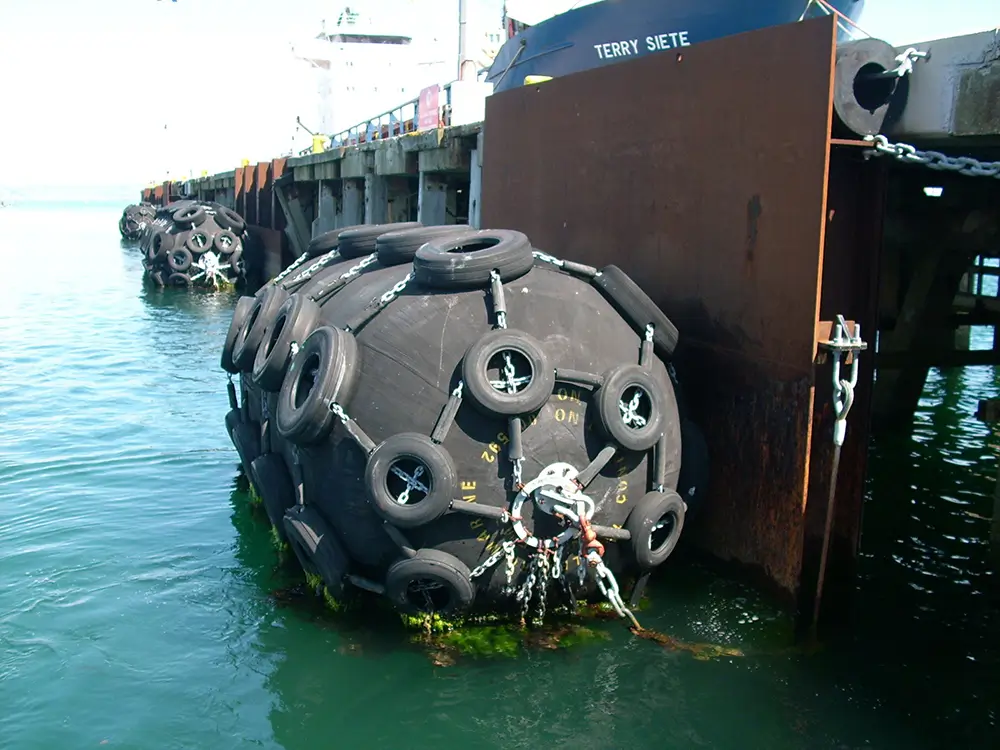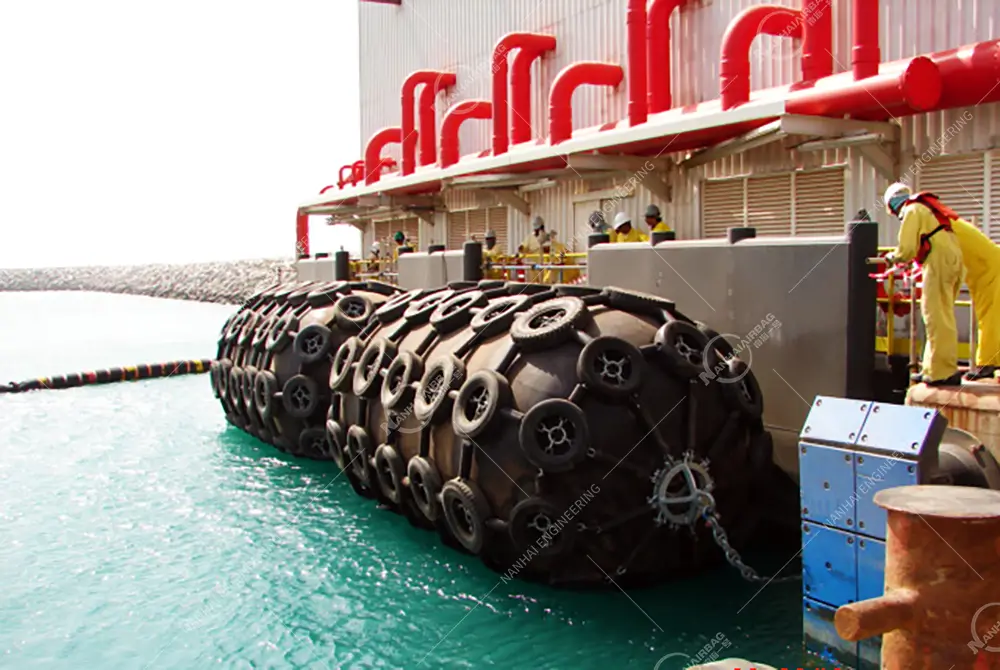How do I prevent ship launching airbags failure?
08/11/2025When Are Hydropneumatic Fenders Necessary?
08/13/2025Can I add a tire net to the existing pneumatic fenders?
If you’ve been working at a busy port or shipyard, you’ve probably seen pneumatic fenders wrapped in a grid of chains and old tires. That’s the famous chain & tyre net (CTN) — a rugged shield that keeps the fender safe from sharp edges, heavy berthing forces, and constant wear.
But what if your fenders didn’t come with one in the first place? Can you add a tire net to the pneumatic fenders you already have?
The short answer: Yes, in most cases you can — especially with sling-type fenders — as long as you check compatibility and follow proper installation steps.
In this article, we’ll walk you through what a tire net is, why it’s worth adding, how to check if your fender is suitable, installation basics, maintenance tips, and how NANHAI can help.

What Is a Chain & Tyre Net?
A chain & tyre net is exactly what it sounds like — a protective mesh made of linked chains and recycled tires (sometimes with rubber sleeves). The chains form the net’s structure, while the tires absorb impacts and spread loads across a larger area.
This system acts like armor for your fender, shielding it from direct contact with ship hulls, sharp corners, and abrasive surfaces. It’s especially valuable in high-traffic or heavy-duty berthing environments where bare fenders would wear down much faster.

Main Benefits of Adding a Tire Net
Adding a tire net to your pneumatic fenders can deliver several benefits:
- Extra Protection Against Damage
Tires prevent direct rubbing between the ship and the fender body, avoiding cuts, punctures, and abrasion. - Better Load Distribution
The net spreads the berthing force across multiple contact points, reducing stress on the fender body. - Improved Stability in Shear Loads
In berthing situations with angled or sliding contact, the tire net reduces movement and twisting. - Longer Service Life
By reducing surface wear, you can extend the fender’s usable lifespan and reduce replacement costs. - Adaptability
Tire nets can be replaced or upgraded without changing the fender itself.
Can You Add a Tire Net to Existing Pneumatic Fenders? — Compatibility Checklist
While most sling-type and many standard pneumatic fenders can be retrofitted with a tire net, you should check these points first:
- End Fittings and Attachment Points
Make sure the fender’s end flanges, D-rings, or shackles are strong enough to handle the extra load. - Fender Condition
Avoid retrofitting onto a heavily damaged or aging fender that may fail under extra strain. - Size and Dimensions
The net must match the fender’s diameter and length to ensure a snug, even fit. - Buoyancy and Pressure
The added weight of the net will slightly affect buoyancy; check if this impacts your application. - Mooring Structure Strength
The dock or ship fittings where the fender is secured must handle the total load with the net installed.
Tip: If your fender has no visible lifting lugs or tie points, you may need to weld or bolt special brackets — always follow manufacturer guidelines.
Standards and Guidelines
Whenever possible, follow ISO 17357 standards for pneumatic fenders and the specific retrofit instructions from your fender manufacturer.
NANHAI’s technical team always checks both international standards and port authority rules before carrying out an installation.
Retrofit & Installation Process — Step by Step
1. Site Inspection and Measurement
Check the fender’s current condition, record dimensions, and identify all attachment points.
2. Material Selection
Choose corrosion-resistant chains (hot-dip galvanized or stainless steel) and tires (car, truck, or aircraft types depending on size). Rubber sleeves are optional for extra hull protection.
3. Net Assembly
Lay out chains on the ground, position tires evenly, and secure them with cross chains.
4. Fender Preparation
Deflate slightly if needed for easier fitting, then position the fender securely on the dock or in a sling.
5. Net Installation
Wrap the net over the fender, aligning vertical and horizontal chains, then tighten with shackles and tensioners.
6. Final Checks
Inspect chain tension, shackle pins, and end fittings. Perform a load or buoyancy test if required.
Safety Tip: Always use proper lifting gear and PPE. Avoid working under suspended loads.
Inspection and Maintenance
A tire net is not “fit and forget.” Here’s how to keep it in top shape:
- Daily / Before Use: Quick visual check for loose shackles or shifted tires.
- Monthly: Inspect for chain corrosion, tire cracks, and rubber sleeve wear.
- Yearly: Remove the net for a full check, replace worn parts, and reapply anti-corrosion coating.
Promptly replace any damaged chain links or tires to avoid safety risks.
Cost and ROI
Adding a tire net involves material, labor, and possible downtime, but in high-wear environments, the savings are clear. Ports that retrofit their fenders with CTNs often report 20–40% longer fender lifespan and fewer emergency repairs.
The investment typically pays back in reduced replacement costs and less unplanned downtime.
NANHAI’s Chain & Tyre Net Solutions
At NANHAI, we don’t just supply pneumatic fenders — we provide custom CTN retrofit services. Whether you need a single net or a full port-wide upgrade, our team can:
- Inspect your current fenders for compatibility.
- Design a net with the right chain grade, tire type, and protective sleeves.
- Handle on-site installation with minimal downtime.
- Provide ongoing maintenance plans.
If you’re considering a retrofit, talk to us — we’ll help you get the most from your fenders.
FAQ
1. Can all pneumatic fenders have a tire net added?
No, but most sling-type and many standard models can. The key is having strong attachment points.
2. Will a tire net affect fender performance?
It can improve stability and reduce wear without significantly affecting buoyancy if installed correctly.
3. How often should I check the tire net?
Do a quick check before use, monthly detailed inspections, and a yearly full maintenance.
4. What materials are best for the chains?
Hot-dip galvanized or stainless steel (SUS304 / SUS316) for corrosion resistance.
5. Can NANHAI install the tire nets on-site?
Yes. We offer on-site retrofit and installation worldwide.
Conclusion
Adding a chain & tyre net to your existing pneumatic fenders is often a smart move, especially if your port sees heavy or frequent berthing. With the right compatibility checks, quality materials, and professional installation, you’ll boost protection and extend service life.
NANHAI is ready to guide you from inspection to installation — and keep your fenders working hard for years to come.
